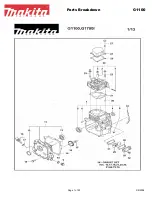
Appendix D. ModBus Management Support and Memory
Map
ROS® v3.11User Guide
130
RMC30
For example, consider a “Write Multiple Registers” request to clear alarms in the device.
0x10
0x00
0x80
0x00
0x01
2
0xFF
0x00
• FF 00 for register 00 80 clears the system alarms
• 00 00 does not clear any alarms
The response may look like:
0x10
0x00
0x80
0x00
0x01
D.1.3. Uint16
This format describes a Standard Modbus 16-bit register.
D.1.4. Uint32
This format describes Standard 2 Modbus 16-bit registers. The first register holds the most
significant 16 bits of a 32 bit value. The second register holds the least significant 16 bits of
a 32 bit value.
D.1.5. PortCmd
This format describes a bit layout per port, where 1 indicates the requested action is true, and
0 indicates the requested action is false.
PortCmd provides a bit layout of a maximum of 32 ports; therefore, it uses two Modbus
registers:
• The first Modbus register corresponds to ports 1 – 16.
• The second Modbus register corresponds to ports 17 – 32 for a particular action.
Bits that do not apply to a particular product are always set to zero.
A bit value of 1 indicates that the requested action is true. For example: the particular port
is “up”.
A bit value of 0 indicates that the requested action is false. For example: the particular port
is “down”.
Reading data using PortCmd:
For example, consider a Modbus Request to read multiple registers from location 0x03FE.
0x04
0x03
0xFE
0x00
0x02
The response depends on how many ports are available on the device. For example, if the
maximum number of ports on a connected RuggedCom device is 20, the response would look
like the following:
0x04
0x04
0xF2
0x76
0x00
0x05
In this example, bytes 3 and 4 refer to register 1 at location 0X03FE, and represent the status
of ports 1–16. Bytes 5 and 6 refer to register 2 at location 0x03FF, and represent the status









































